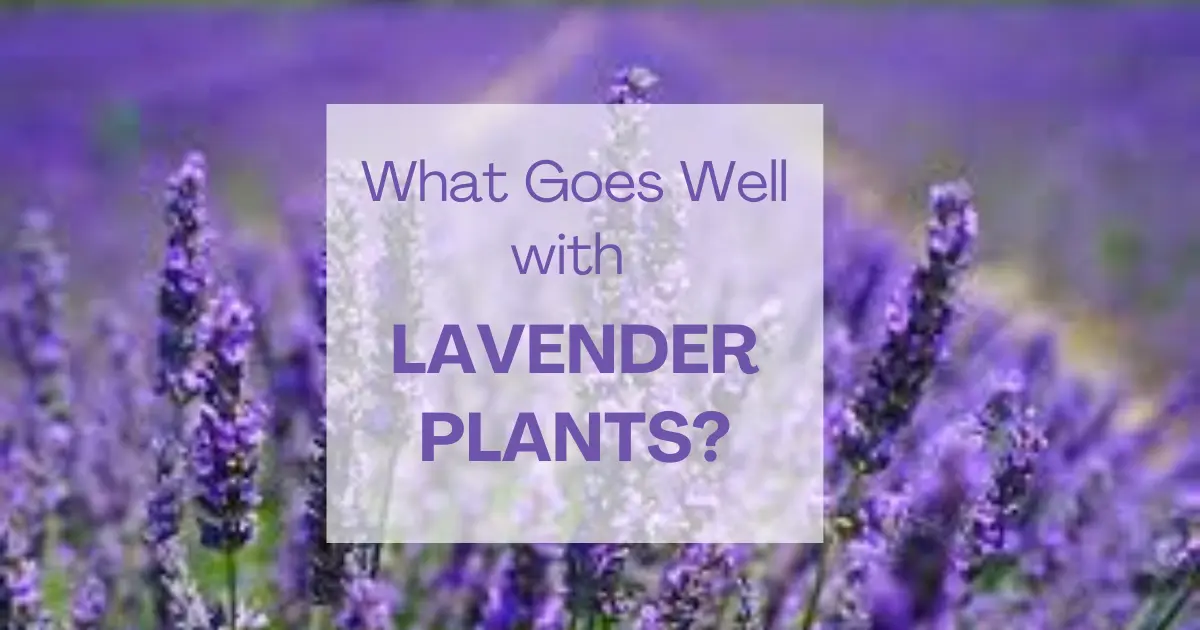Lavender plants are more than just a fragrant addition to your garden; they’re a visual delight and a haven for pollinators. But have you ever wondered what other plants thrive alongside lavender? Whether you’re looking to create a stunning floral display, maximize your garden’s health, or simply enjoy a more fragrant outdoor space, pairing lavender with the right companions can make all the difference. Let’s dive into the best plants that complement lavender and how to ensure your garden flourishes.
What Plants Complement Lavender in the Garden?
Lavender plant is known for its hardiness, drought tolerance, and stunning purple blooms, but it truly shines when paired with the right plants. The key to choosing companion plants for lavender lies in understanding its needs and characteristics.
Lavender plants prefer full sun, well-drained soil, and minimal watering. Therefore, it’s best to pair it with plants that have similar growing conditions. Below, we’ll explore some top companions for lavender and why they work so well together.
1. Rosemary: A Fragrant Match
Rosemary is a classic companion for lavender plants. Both herbs thrive in similar conditions, making them perfect partners in the garden. Rosemary’s spiky green leaves contrast beautifully with lavender’s soft purple flowers, creating an eye-catching display.
Why It Works:
- Both plants love full sun.
- Require similar watering schedules.
- Complementary fragrances add depth to your garden’s aroma.
Lavender and Rosemary Growing Conditions:
| Plant | Sunlight | Soil Type | Watering Needs | Ideal Companion |
|---|---|---|---|---|
| Lavender | Full Sun | Well-drained | Low | Rosemary |
| Rosemary | Full Sun | Well-drained | Low | Lavender |
2. Echinacea: Adding a Pop of Color
Echinacea, also known as coneflower, is another great companion for lavender. Echinacea’s bright, daisy-like flowers not only add a splash of color but also attract bees and butterflies, enhancing the biodiversity of your garden.
Why It Works:
- Tolerant of drought and poor soil conditions.
- Blooms at the same time as lavender plants, creating a cohesive look.
- Attracts beneficial pollinators.
Benefits of Pairing Lavender and Echinacea:
| Benefit | Lavender | Echinacea |
|---|---|---|
| Drought Tolerance | Yes | Yes |
| Pollinator Attraction | Yes | Yes |
| Blooming Season | Summer | Summer |
3. Thyme: Groundcover that Enhances
Thyme is a low-growing herb that makes an excellent ground cover around lavender plants. Its small, aromatic leaves create a lovely contrast with lavender’s taller stems, while also helping to suppress weeds.
Why It Works:
- Thrives in similar soil and light conditions.
- Acts as a natural mulch, retaining soil moisture.
- Adds a layer of texture to your garden.
Lavender and Thyme: A Groundcover Combo:
| Feature | Lavender | Thyme |
|---|---|---|
| Soil Type | Well-drained | Well-drained |
| Growth Habit | Upright | Low-growing |
| Weed Suppression | Moderate | High |
4. Sedum: A Succulent Partner
Sedum is a succulent plant that pairs beautifully with lavender plants. It’s perfect for adding variety to a dry, sunny garden, and its fleshy leaves contrast nicely with lavender’s delicate flowers.
Why It Works:
- Requires little water, just like lavender plants.
- Tolerant of poor, rocky soil.
- Adds a unique texture and color variation to your garden.
Comparing Lavender Plants and Sedum:
| Characteristic | Lavender | Sedum |
|---|---|---|
| Watering Needs | Low | Low |
| Soil Preference | Well-drained | Rocky/Gravelly |
| Color Contrast | Purple | Green/Pink |
How to Care for Lavender and Its Companions?
Now that you know which plants go well with lavender, it’s important to understand how to care for this ensemble to keep your garden thriving. Here’s a brief guide to ensuring all your plants, including lavender, remain healthy and vibrant.
1. Watering Techniques
Lavender is drought-tolerant, but it’s crucial to get the watering right. Overwatering can lead to root rot, so ensure the soil is well-drained. Water deeply but infrequently, allowing the soil to dry out between waterings.
- For Lavender: Water once every two weeks during the growing season.
- For Companions: Follow similar watering schedules for rosemary, thyme, and sedum. Echinacea may need a bit more water, especially in extreme heat.
2. Pruning and Maintenance
Pruning lavender regularly encourages healthy growth and abundant blooms. After the first flowering, trim back the plants to keep them tidy and promote a second bloom.
- Rosemary: Prune after flowering to maintain shape.
- Echinacea: Deadhead spent flowers to encourage more blooms.
- Thyme and Sedum: Prune lightly to remove any dead or overgrown parts.
Pruning Schedule for Lavender and Companions:
| Plant | Best Time to Prune | Purpose of Pruning |
|---|---|---|
| Lavender | After first bloom | Encourage growth |
| Rosemary | After flowering | Maintain shape |
| Echinacea | Throughout blooming season | Encourage continuous blooms |
| Thyme | As needed | Remove dead growth |
| Sedum | Early spring | Stimulate new growth |
3. Soil and Fertilization
Lavender thrives in poor, sandy, or gravelly soil with excellent drainage. Fertilizing is not always necessary for lavender, but if you do, opt for a low-nitrogen fertilizer to avoid overly lush foliage at the expense of blooms.
- Companion Plants: Most of lavender’s companions prefer similarly poor soils. Avoid heavy fertilization as it can lead to weak growth.
4. Pest and Disease Management
Lavender is relatively pest-free, but overwatering or poor air circulation can lead to issues like root rot or mildew. Ensure good airflow around your plants by spacing them appropriately and avoiding overhead watering.
- For Echinacea: Watch for aphids and mites; treat with insecticidal soap if needed.
- For Thyme and Rosemary: Generally pest-resistant, but watch for fungal diseases in humid climates.
Common Pests and Diseases:
| Plant | Common Issues | Prevention/Treatment |
|---|---|---|
| Lavender | Root rot, mildew | Ensure proper drainage |
| Rosemary | Powdery mildew | Prune for airflow, avoid overhead watering |
| Echinacea | Aphids, mites | Insecticidal soap |
| Thyme | Fungal diseases | Avoid humid conditions |
| Sedum | None significant | Generally pest-free |
What Should You Avoid Planting with Lavender?
Not all plants make good companions for lavender. Some may have different water, soil, or sunlight needs, leading to poor growth or even plant failure. Let’s take a look at what plants you should avoid planting near lavender.
1. Mint: Too Much Moisture
Mint is a popular herb, but it requires much more moisture than lavender. Planting them together can lead to overwatering issues for lavender, potentially causing root rot.
2. Hostas: Shade Lovers
Hostas thrive in shade and moist soil, which is the opposite of what lavender needs. Pairing these two plants would result in one of them failing to thrive.
3. Camellias: Acid-Loving Plants
Camellias prefer acidic, rich soil, while lavender thrives in alkaline, well-drained soil. Planting them together would likely result in poor growth for both.
Plants to Avoid with Lavender:
| Plant | Reason for Avoiding |
|---|---|
| Mint | Requires too much moisture |
| Hostas | Prefers shade, moisture |
| Camellias | Needs acidic soil |
Conclusion
Lavender is a versatile and beautiful addition to any garden, especially when paired with the right companions. By choosing plants like rosemary, echinacea, thyme, and sedum, you can create a garden that is not only visually stunning but also low-maintenance and beneficial for pollinators. Remember to consider the growing needs of each plant, including sunlight, soil type, and watering schedule, to ensure a thriving garden.
FAQs
What soil type is best for lavender and its companions?
Lavender and its companions like rosemary and thyme thrive in well-drained, sandy, or gravelly soil with minimal fertilization.
How often should I water lavender plants and its companion plants?
Water lavender plants deeply but infrequently, about once every two weeks. Follow similar schedules for rosemary, thyme, and sedum. Echinacea may need more frequent watering in hot weather.
Can I plant lavender in a shaded area?
Lavender plants prefer full sun and won’t thrive in shade. Plant it in a sunny spot for the best results.
What should I avoid planting near lavender plants?
Avoid plants that require more moisture, such as mint, or those that prefer shade and acidic soil, like hostas and camellias.
How do I prune lavender and its companion plants?
Prune lavender after the first bloom to encourage growth. Prune rosemary and thyme to maintain shape and remove dead growth. Echinacea should be deadheaded throughout the season to encourage continuous blooming.
Incorporating lavender plants into your garden is a fantastic way to add beauty, fragrance, and a touch of elegance. By understanding what goes well with lavender plants and how to care for them, you can create a harmonious and thriving garden that will be the envy of all who see it!

